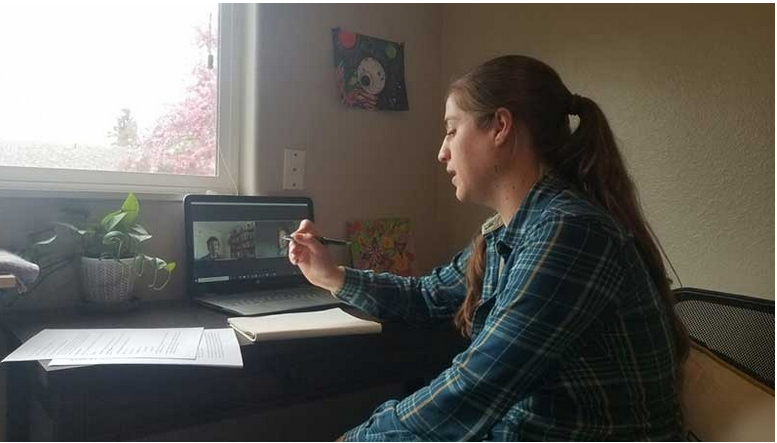
“Rich and crazy” is how Sergio B. Sanchez describes the street art he observed growing up in his Chicano community of Santa Ana, California.
Sanchez is now a University of Oregon senior who aspires to use his talent to inspire at-risk youth. That in turn inspired fellow student Noeli Martinez-Gabriel to choose Sanchez as the subject of a class project, just as the class went remote in response to the coronavirus pandemic.
Sanchez is the subject of Martinez-Gabriel’s final project in the Latino Roots II class taught this quarter by Lynn Stephen and Gabriela Martínez. Stephen is a professor of anthropology, while Martínez is a professor of journalism. Their Latino Roots class sequence allows students to produce oral histories and films documenting Oregon’s Latino community.
When classes moved to remote teaching, the veteran professors decided to push themselves and their students forward, despite the unknown.
“We’re teaching how to interview on Zoom,” said Stephen, the Philip H. Knight Chair of anthropology. “We did a whole session on it, where you direct your subject, where you work with lighting, where you also do your best with sound.”
The class, which the pair is teaching for the fifth time, is a two-part sequence. The winter term section, Latino Roots I, was spent learning Latino history in Oregon and understanding the process of recording oral history.
Having gained that context and skill set, Latino Roots II students from many disciplines, including anthropology, ethnic studies, Latin American studies and journalism, usually spend spring term producing a documentary film on a single subject.
Those projects are now being adapted to social distancing. Martinez-Gabriel, who will be capturing Sanchez remotely, has been talking with the artist to find a documentary style that honors his work.
“Since he agreed to be part of my documentary, I told him this project was a collaborative process,” Martinez-Gabriel said.
When everything went remote, communication was even more key. The two agreed on a virtual interview so that Sanchez could make a creative decision about his backdrop.
Martinez-Gabriel won’t be able to make footage of him doing his graffiti-style artwork, but she’s glad that through the use of technology, she still gets to tell his story.
Students are being instructed to coach their subjects in camera positioning and wearing earbuds with a good microphone included to optimize audio, Martínez said.
“Obviously, we know that this is not going to be perfect,” she said. “And obviously we’re going to have some leeway there. But we’re encouraging everybody to work with their participants to get the best that they can get.”
Controlling for conditions like lighting, image cropping, background noise and more, subjects will likely take a more active role in these projects than they have in the past.
What will count most this time around is how well the story is told, Martínez said, not the technical expertise used to tell it. But she anticipates the experimental documentary styles will produce some strong results.
The added reliance on technology and lack of access to equipment normally lent to students by the School of Journalism and Communication is exposing some digital inequality, both professors said.
This term’s online demands call for upgrades to Wi-Fi speed and an outdated modem for student Kate Weiss. But she is grateful to have a reliable laptop to work from home, she said.
Other students don’t have newer laptops or Wi-Fi access at home. College has always been the great equalizer, Martínez said, “But once we hit a situation like this, we see the differences.”
Through the anthropology department, Stephen was able to check out five cameras to individual students off her front porch from a safe distance. They’ll keep them for the entire term.
All students have also been granted free access to Adobe Premier and received Zoom tutorials in editing video from cinema studies support instructor Kevin May. He would normally assist the class in-person in a campus media lab, but he has adapted to remote instruction, which students say has been invaluable.
While some students are featuring family members or roommates, many are reaching outside their close social circles to focus on neighbors or other community members. The goal of the project is “profiling the complexities, uniqueness and contributions of Latino immigrants in the state” and working against stereotypes, Stephen said.
Doctoral candidate Kisa Clark chose to document state Rep, Teresa Alonso Leon, whose jurisdiction is Woodburn as well as north Salem and Keizer.
“I was interested in telling Teresa’s story because she is a strong advocate for her majority Latino community and the largest Latino community in the state,” Clark said.
Some footage of Alonso Leon had already been captured in March, and Clark will intersperse that with Zoom footage and archival images.
“I am lucky to have some material from pre-pandemic,” Clark said, “but this situation has certainly changed many of my hopes for the project.”
After completion, the projects will be archived in the Knight Library special collections and published on the class website, latinoroots.uoregon.edu.
The course’s completion is normally celebrated with a public reception for a couple hundred people at the library, including an address from UO President Michael Schill. Select leaders from the Latino community are also invited to speak at each event, which also includes screenings of the films, a live band and food. Given the coronavirus situation, Stephen and Martínez plan to do their best to recreate that occasion virtually.
The strength of the class community built over two terms makes the strange circumstances of remote learning a little easier to bear, Stephen said.
“The sense of intimacy that there is through Zoom is, of course, facilitated by those prior relationships,” she said. “If we didn’t know them and we were meeting them for the first time, it would be very different. (These students) know and trust each other.”
— By Anna Glavash, University Communications, originally posted on Around the O
